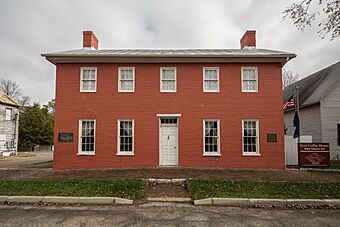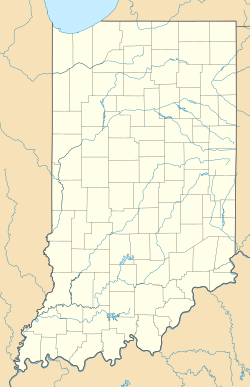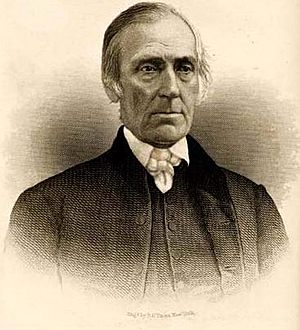Levi Coffin House facts for kids
|
Levi Coffin House
|
|
 |
|
| Location | Fountain City, Indiana |
|---|---|
| Area | less than one acre |
| Architectural style | Federal |
| NRHP reference No. | 66000009 |
Quick facts for kids Significant dates |
|
| Added to NRHP | October 15, 1966 |
| Designated NHL | June 23, 1965 |
The Levi Coffin House is a very important historic home located in Fountain City, Indiana. It's a two-story brick house with eight rooms, built around 1838–1839. This house became famous as the "Grand Central Station" of the Underground Railroad. This was because it was a meeting point for three escape routes to the North. Many freedom seekers passed through its doors.
The original owners, Catharine and Levi Coffin, were Quaker abolitionists. This means they were people who strongly believed in ending slavery. They helped freedom seekers by giving them supplies and a safe place to rest. The Coffins lived in Indiana for twenty years, from 1826 to 1847. During this time, they are believed to have helped as many as 2,000 freedom seekers escape to freedom. They went to the Northern United States and even to Canada.
After moving to Ohio in 1847, the Coffins continued their work. They helped about 1,300 more freedom seekers. In 1966, the Coffin's Indiana home was the first property in the state to be added to the National Register of Historic Places. Today, the Levi Coffin House Association manages the property. It is open to the public for tours from June through October. The History Channel called it "one of the nation’s Top 25 Historical Sites." In 2016, the Smithsonian named its Interpretive Center "one of 12 new museums around the world to visit."
Contents
The Coffin Family and the Underground Railroad
Who Were Levi and Catharine Coffin?
Catharine and Levi Coffin moved from Guilford County, North Carolina, to Wayne County, Indiana, in 1826. They settled in a town called Newport, which is now Fountain City. They came to join other members of the Coffin family.
Levi Coffin (1798–1877) was a Quaker and a strong opponent of slavery. He was a businessman and a kind person. He became a very active leader in the Underground Railroad in both Indiana and Ohio. Because he helped so many freedom seekers, he was unofficially called the "President of the Underground Railroad." Catharine (White) Coffin (1803–81) also played a big part. She provided food, clothing, and a safe place for freedom seekers in their home.
Helping Freedom Seekers Escape
The Coffins started sheltering freedom seekers in Indiana during the winter of 1826–1827. Their home became one of many stops on the Underground Railroad. This was a secret network that helped freedom seekers travel north to freedom in Canada. "Conductors" on the Underground Railroad guided freedom seekers through Kentucky. They usually crossed the Ohio River at places like Madison, Indiana, Jeffersonville, Indiana, or Cincinnati, Ohio. After crossing, many were led to the Coffin House.
The Coffins and their neighbors gave freedom seekers supplies and a place to stay. They stayed until they could be moved further north. Levi Coffin later guessed that they helped about one hundred freedom seekers escape each year. The Coffins did not keep records of their activities. This was because helping freedom seekers was against the law. However, it is believed they helped about 2,000 people find freedom in the North and Canada. This was during the twenty years they lived in Indiana.
The Coffin House in Literature
Harriet Beecher Stowe wrote a famous book called Uncle Tom's Cabin. This book told stories of freedom seekers escaping on the Underground Railroad. Stowe lived in Cincinnati when she wrote the novel. She knew the Coffins, and they might have inspired the characters Simeon and Rachael Halliday in her story.
Stowe's book tells the story of Eliza Harris. She was a freedom seeker from the South. She escaped by crossing the frozen Ohio River with her baby on a winter night. After getting food, clothes, new shoes, and shelter from the Hallidays, Eliza continued her journey to freedom.
Life After Indiana
Friends in the anti-slavery movement asked the Coffins to move. So, in 1847, they left Newport and moved to the Cincinnati, Ohio, area. There, they managed a store that sold "free-labor goods." These were products made without the use of slave labor. Levi Coffin sold the business in 1857. He realized it was hard to make a profit. But the Coffins continued to be leaders in the Underground Railroad. It's thought they helped 1,300 more freedom seekers in their Ohio home.
Later, Levi Coffin worked for the Western Freedman's Aid Society. He asked the U.S. government to create the Freedmen's Bureau. In 1867, he went to the International Anti-Slavery Conference in Paris. After that, he retired from public life.
The Coffin House: A Safe Haven
Why "Grand Central Station"?
The Coffin family's home was built around 1838–1839. It became a state historic site later. Its location was special. Three escape routes to the North met there. Also, many freedom seekers passed through the home. This is why it became known as the "Grand Central Station" of the Underground Railroad.
Slave-catchers sometimes suspected the house. But Levi Coffin would demand to see a search warrant and papers proving slave ownership. He would not let them in without these documents. By the time the slave-catchers went to the county seat of Centerville (a 26-mile round trip) to get the papers, the freedom seekers would have been moved to other safe places. The Coffin home in Indiana kept helping freedom seekers even after the Coffins moved to Ohio in 1847.
A Home with Secrets
The Coffin home is located at 113 U.S. Route 27 in Fountain City, Indiana. It's a two-story brick house, painted red. It has a two-story section at the back. The house faces east, with its main door on Main Cross Street. Another door on Mill Street leads to the back section.
The inside of the house has eight rooms. It is furnished to look like a Quaker family's home in Indiana during the 1840s. The original fireplaces, doors, floors, and some woodwork have been fixed up. The main entrance opens into a central hallway. There is a room on each side and stairs going up to the second floor. The room on the south side of the main floor has original built-in bookshelves. The north room was the parlor. It leads to a dining room in the back section. Stairs go down to a kitchen and a spring room in the basement. A well fed by a spring in the basement gave the home fresh water. The second floor has three bedrooms.
The Coffin home had special features that could be used as hiding places. Most rooms had at least two ways to exit. There was a secret door in the maids' quarters on the second floor. This door led to a narrow space between the walls. As many as fourteen freedom seekers could hide there. The upstairs rooms could also hold extra visitors. The home also had a large attic and storage areas.
Becoming a Historic Site
The Coffin house was named a National Historic Landmark. In 1966, it was the first property in Indiana added to the National Register of Historic Places. Indiana's state government bought the house in 1967. They leased it to the Wayne County Historical Society. The home has been restored to look like it did in the 1840s when the Coffins lived there. After being restored, the home opened to the public as a historic site in 1970.
Today, the Indiana State Museum and Historic Sites manages the house. It is open for tours from 10 a.m. to 5 p.m., Wednesday through Sunday.
Images for kids
See also











